Baháʼí House of Worship
A Bahá'í House of Worship or Bahá'í temple is a place of worship of the Bahá'í Faith. It is also referred to by the name Mashriqu'l-Adhkár (مشرق اﻻذكار), an Arabic phrase meaning "Dawning-place of the remembrance of God."[1] The teachings of the religion envisage Houses of Worship being surrounded by a number of dependencies dedicated to social, humanitarian, educational, and scientific pursuits, although none has yet been built to such an extent.[2][3] The Houses of Worship are open to the public, and are exclusively reserved for worship, where sermons are prohibited and only scriptural texts may be read or chanted. Most Bahá'í meetings occur in local Haziratu'l-Quds (commonly known as Bahá'í centres), individuals' homes, or rented facilities,[2] though plans for the first five local Houses of Worship were announced in 2012, with that in Battambang, Cambodia being the first to open, in 2017.
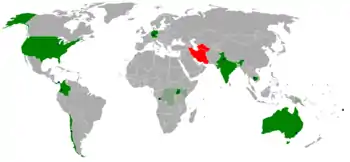
| Part of a series on |
| Baháʼí Faith |
|---|
 |
Eleven Bahá'í Houses of Worship have been built around the world (including one in Ashgabat, Turkmenistan that has since been destroyed).[4] Of the ten currently standing, eight are continental temples and two are local temples. Two of the continental temples, the Lotus Temple and the Santiago Bahá'í Temple, have won numerous architectural awards. In the Ridván Message for 2012, the Universal House of Justice announced new initiatives for future Houses of Worship, calling for the first national and locally based institutions.[5] As of 2021, the groundbreaking for the first "national Mashriqu'l-Adhkárs" has occurred, while the first two local Houses of Worship have been opened. Bahá'í communities own many properties where Houses of Worship remain to be constructed as the Bahá'í community grows and develops further.
Description
The Bahá'í House of Worship was first mentioned in Baháʼu'lláh's book of laws, the Kitáb-i-Aqdas, as the Mas͟hriqu'l-Ad͟hkár (Arabic: مشرق اﻻذكار "Dawning-place of the remembrance of God"), and the details of the institution were then elaborated by both Baháʼu'lláh and his successor, ʻAbdu'l-Bahá.[3]
Bahá'í literature directs that a House of Worship should be built in each city and town, and emphasizes that its doors must be open to all regardless of religion, or any other distinction. The Bahá'í laws emphasize that the spirit of the House of Worship must be a gathering place where people of all religions may worship God without denominational restrictions.[3] The Bahá'í laws also stipulate that only the holy scriptures of the Bahá'í Faith and other religions can be read or chanted inside in any language; while readings and prayers may be set to music by choirs, no musical instruments may be played inside.[3] Furthermore, no sermons may be delivered, and no ritualistic ceremonies practiced.[3]
All Bahá'í temples share certain architectural elements, some of which are specified by Bahá'í scripture. ʻAbdu'l-Bahá stipulated that an essential architectural character of a House of Worship be that it requires to have a nine-sided shape (nonagon).[6] While all current Bahá'í Houses of Worship have a dome, they are not regarded as an essential part of their architecture.[7] Bahá'í scripture also states that no pictures, statues or images may be displayed within the House of Worship and no pulpits or altars incorporated as an architectural feature (readers may stand behind simple portable lectern).[3] To date all the Houses of Worship built or planned have a single, undivided room under their dome. Furthermore, in all ten, the seats in the auditorium face the Shrine of Baháʼu'lláh in 'Akká, Israel. While each of the Houses of Worship is unique, the designs, through the selection of materials, landscaping and architecture, reflect the indigenous cultural, social and environmental elements of their location, to a greater or lesser degree.[3]
Bahá'í literature also stipulates that the Houses of Worship be surrounded by a complex of humanitarian, educational, and charitable institutions such as schools, hospitals, homes for the elderly, universities, hostels, and other social and humanitarian institutions to serve the areas in which they stand.[3][8] Shoghi Effendi, head of the religion in the first half the 20th century, stated that the functions of the House of Worship would be complementary to those of the Haziratu'l-Quds (a.k.a. Bahá'í centres), and that it would be desirable if both these buildings would be on the same site.[9][10] He also describes the future interaction between the Mas͟hriqu'l-Ad͟hkár (worship) and its dependencies (service) as "capable of removing the ills that have so long and so grievously afflicted humanity".[11]
The ten existing Houses of Worship were built as the Bahá'í community could support their construction through voluntary contributions. There are no collections during services and only Bahá'ís are permitted to contribute to the Bahá'í funds, including funds for the construction and maintenance of the House of Worship. The Houses of Worship are administered and maintained by the National Spiritual Assembly of the Bahá'ís of the country in which they are located.[3]
The Shrine of the Báb and other buildings at the Bahá'í World Centre are not Houses of Worship, although tourists often mistakenly refer to the Shrine as a Bahá'í temple.
Destroyed House of Worship in Turkmenistan
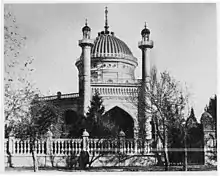
The first Bahá'í House of Worship was built in the city of ʻIshqábád, then ruled by Russia and now the capital of Turkmenistan. It was started in 1902 and completed in 1908. The design was prepared by Ostad Ali-Akbar Banna, and the construction was supervised by Vakílu'd-Dawlih, later named one of the nineteen Apostles of Baháʼu'lláh.[3][12]
ʻIshqábád is located in the desert plain of western Turkmenistan near the foothills of the Alborz Mountains. Under the protection and freedom given by the Russian authorities, the number of Bahá'ís there rose to over 1,000 and for the first time anywhere in the world a true Bahá'í community was established, with its own schools, medical facilities, cemetery, etc. Eventually the Bahá'ís in ʻIshqábád decided to build the institution of the spiritual and social heart of the Bahá'í community: the Mas͟hriqu'l-Ad͟hkár.
The House of Worship itself was surrounded by gardens. At the four corners of the garden were four buildings: a school, a hostel where travelling Bahá'ís were entertained, a small hospital, and a building for groundskeepers. The Bahá'ís lived as much as possible in proximity to the House of Worship. It was the centre of the community materially, as well as spiritually. The House of Worship in ʻIshqábád has been the only house of worship thus far to have the humanitarian subsidiaries associated with the institution built alongside it.[12]
After serving the community for two decades, the House of Worship was expropriated by the Soviet authorities in 1928 and leased back to the Bahá'ís. This lasted until 1938, when it was fully secularized and turned into an art gallery. The 1948 Ashgabat earthquake seriously damaged the building and rendered it unsafe; the heavy rains of the following years weakened the structure, and it was demolished in 1963 and the site converted into a public park.[3]
Continental Houses of Worship
There are currently ten Bahá'í Houses of Worship. The newest Bahá'í House of Worship, located in the municipality of Villa Rica in the Cauca Department, Colombia, opened its doors on July 23, 2018.
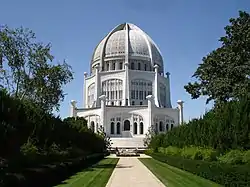
Wilmette, Illinois, U.S.
The cornerstone for the Bahá'í House of Worship in Wilmette, Illinois was brought to the site by Nettie Tobin and accepted in 1912 by ʻAbdu'l-Bahá during his only visit to the United States and Canada. Construction began in 1921 and was completed in 1953, with a delay of several years during the Great Depression and World War II. The Wilmette House of Worship is the largest and the oldest surviving Bahá'í House of Worship. Known by Baha'is as the "Mother Temple of the West" and formally as the "Bahá'í House of Worship for the North American Continent", it stands in north suburban Cook County, on the shores of Lake Michigan, at 42°04′27.88″N 87°41′05.89″W. The cladding is made of white portland cement concrete with both clear and white quartz aggregate. It has received numerous design awards, and is a prominent Chicago-area landmark. In 1978, it was added to the National Register of Historic Places.[13]
The height of the auditorium is 138 feet (42 m), and the diameter of the dome is 90 feet (27.5 m). From ground level, which is 597 feet above sea level just on the west side of Sheridan Road, the building stands approximately 164 feet tall above ground level. The auditorium seats 1,192 visitors.[14] Like some other Bahá'í temples, it has a gallery balcony from which choirs or soloists may perform. No instrumental music is allowed during services in the auditorium, although all kinds of music may be performed in the meeting room below. In general, no videography, photography, or any other activity inconsistent with quiet meditation is allowed in the auditorium. Devotional programs are held daily at 9:15 a.m. and 12:30 p.m.

Foundation Hall, which is used for large meetings and holy day celebrations is located underneath the main auditorium. The large underground area also contains offices not regularly open to the general public, including a media center, studios, and the Baha'i Archives, which can be visited by appointment. As of May, 2015, the displays, restrooms, offices, bookstore, and the viewing room for videos have been moved to a newly constructed Welcome Center located between the gardens and the parking lot to the southwest of the House of Worship. The previous Visitor's Center is no longer routinely open to the public.
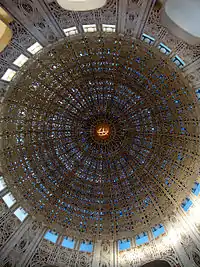
The principal architect was Louis Bourgeois, but the interior cladding was designed by Alfred Shaw of Shaw, Metz, and Dolio. Engineering plans were prepared by Allen McDaniel of The Research Service of Washington, D.C. The general contractor was George A. Fuller, Co. Both the pioneering exterior and interior cladding were fabricated and constructed by John Joseph Earley and the Earley Studio.[15]
The Bahá'í House of Worship is a place of worship for all people. The only decorative art inside and out involves shapes and designs made by intersecting lines. There are no images of people or places. The building itself is decorated inside and out with verses from the Baha'i Writings, all of them by Baháʼu'lláh. As there are nine entrances to the building, there are nine verses above the doors and nine inside the buildings above the alcoves.
The verses outside are engraved into the stone, in large legible letters. Above the doors are small engraved versions of the "Greatest Name", one of several Bahá'í symbols and an elaborate decorative design that includes the letters ABHA, representing the prayer "Alláh u Abhá" (God is Most Glorious) in Arabic. It is the numerical value of these four letters in the words abha and baha (for Baháʼu'lláh) that add up to total nine, one of reasons Bahá'í Houses of Worship are nine-sided.
The most decorative element on the outside of the building is the tracery on the nine towers. These are intertwined with the generally recognized symbols of many world religions, including the Cross, the star and crescent, the Star of David, and the original swastika design, an ancient symbol having arms bent at right angles, used for thousands of years as a representative symbol of world religions such as Hinduism, Buddhism, and Jainism. The only decorative symbol inside the auditorium is a large, lighted version of the Greatest Name in the exact center of the inside of the dome.
For many years the Bahá'í House of Worship was associated with a "home for the aged", operated by the U.S. Bahá'í community. The Bahá'í Home has since closed, although the building remains in use for a local Baha'i School and regional training center.[16]
On April 30, 2007, the Bahá'í House of Worship was named one of the Seven Wonders of Illinois by the Illinois Bureau of Tourism representing the Chicago metropolitan area.[17]

Kampala, Uganda
The Mother Temple of Africa is situated on Kikaaya Hill, in Kawempe Division, in northern Kampala, Uganda's capital and largest city. It was designed by Charles Mason Remey. Its foundation stone was laid in January 1958, and it was dedicated on January 13, 1961.
The building is more than 130 feet (39 m) high, and over 100 meters in diameter at the base. The dome, composed of lace-like tiles, rises over 124 feet (37 m) high and is 44 feet (13 m) in diameter. The foundation goes 10 feet (3 m) underground to protect it from earthquakes common in this part of the world.
The green dome is made of fixed mosaic tiles from Italy, and the lower roof tiles are from Belgium. The walls of the temple are of precast stone quarried in Uganda. The colored glass in the wall panels was brought from Germany. The timber used for making the doors and benches was from Uganda. The 50-acre (200,000 m2) property includes the House of Worship, extensive gardens, a guest house, and an administrative center.[18]
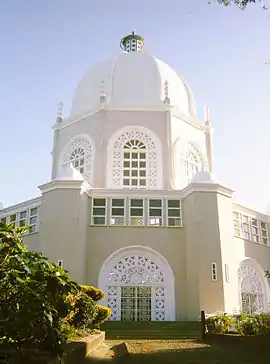
Sydney (Ingleside), New South Wales, Australia
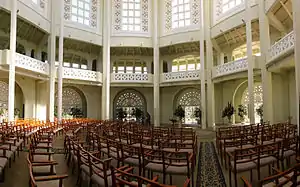
The temple in Ingleside in the northern suburbs of Sydney, Australia was dedicated on September 17, 1961 and opened to the public after four years of construction. The initial design by Charles Mason Remey was approved in 1957, and given to Sydney architect John Brogan to develop and complete. Construction materials include local hardwoods and concrete surmounted by a dome, with seating for six hundred people. The building stands 38 metres in height, has a diameter at its widest point of 20 metres, and is a highly visible landmark from Sydney's northern beaches.[19]
The surrounding gardens contain native plants including waratahs, several grevillea including the unique caleyi, the native pea, wattle and woody pear, plus three species of eucalypts. Other buildings located on the site include a visitor's centre, bookshop, picnic area, hostel, caretaker's cottage, and the administrative offices of the Australian Baha'i community.[20]
The property is set high in a natural bushland setting of 380,000 square metres (38 hectares) in Ingleside, overlooking the Pacific Ocean. This Temple serves as the "Mother Temple of the Antipodes".[21]
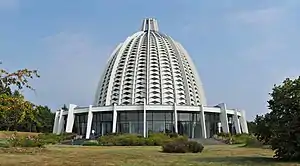
Hofheim-Langenhain, Germany
The Mother Temple of Europe is located at the foot of the Taunus Mountains of Germany, in the village of Langenhain, a suburb of Hofheim, Hesse near Frankfurt. It was designed by Teuto Rocholl. The temple was dedicated on July 4, 1964, after three and a half years of construction, including a performance by Maria Montana.[22] It is made of steel, aluminum, and glass. 540 diamond-shaped windows give the dome an optical lightness and permit the sunlight to play in it. Diameter of the central hall area is 25 meters, while the diameter of the outside ambulatory area is 48 meters. Height from ground level is 28 meters. The outstanding characteristic acoustics of this setting are created by the reverberation within the dome and the resonance of its myriad window ledges. Choirs here sometimes sing while standing around the circumference of the temple floor, with the audience in the center.

Panama City, Panama
The Bahá'í temple in Panama City, Panama, dedicated April 29–30, 1972,[23] designed by Peter Tillotson. It serves as the mother temple of Latin America. It is perched on a high cliff, "Cerro Sonsonate" ("Singing Hill"), overlooking the city, and is constructed of local stone laid in a pattern reminiscent of Native American fabric designs.
The dome is covered with thousands of small oval tiles, and the entrance gates of the temple are constructed in a unique three-dimensional design each consisting of an equilateral triangle of three vertical posts with multiple rows of bars stretching between them at various angles, each row of which gradually changes from vertical to horizontal.
Tiapapata, Samoa
.jpg.webp)
The Bahá'í House of Worship in Tiapapata, 8 km from Apia, Samoa, was dedicated on September 1, 1984, having been completed at a cost of $6,500,000.[24] It serves as the Mother Temple of the Pacific Islands. The temple was designed by Hossein Amanat, and was dedicated by Malietoa Tanumafili II, the reigning O le Ao o le Malo of Samoa[25] (1913–2007) and the world's first Bahá'í head of state. Its 30-meter domed structure is open to the public for individual prayer, commemoration of Baha'i holy days, and weekly devotional meetings. The structure is completely open to the island breezes.

Delhi, India

The Bahá'í temple in Delhi, India was dedicated in December 1986, having been completed for a total cost $10 million.[26] It serves as the Mother Temple of the Indian subcontinent. It has won numerous architectural awards[27] and been featured in many newspaper and magazine articles. The architect was an Iranian, who now lives in Canada, named Fariborz Sahba.
Inspired by the lotus flower, its design is composed of 27 free-standing, marble-clad "petals" arranged in clusters of three to form nine sides.[28]
Nine doors open on to a central hall, capable of holding up to 2,500 people. Slightly more than 40 meters tall, its surface shining white marble, the temple at times seems to float above its 26-acre (105,000 m2; 10.5 ha) nine surrounding ponds. The site is in the village of Bahapur, in the National Capital Territory of Delhi. The major part of the funds needed to buy this land was donated by Ardishír Rustampúr from Hyderabad, Sindh (Pakistan),[29] who gave his entire life savings for this purpose in 1953.[30]
This House of Worship is generally referred to as the "Lotus Temple" by Bahá'ís and non-Bahá'ís alike. In India, during the Hindu festival Durga Puja, several times a replica of the Lotus Temple has been made as a pandal, a temporary structure set up to venerate the goddess Durga.[31]
Santiago, Chile
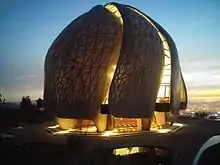
In late 2002, the National Spiritual Assembly of the Bahá'ís of Chile and the Universal House of Justice announced a competition for the design of the mother temple of South America, to be built in Santiago. The chosen design was by Siamak Hariri of Hariri Pontarini Architects in Toronto, Ontario, Canada.[32] The construction completed in October, 2016,[33] with doors opening on October 19, 2016.[34]
The temple's sides and dome are composed of nine wings, each one consisting of a steel space frame with panels of translucent marble and cast glass cladding.[35] The construction phase started in November 2010.[36] It has won a range of Canadian and international architectural awards.[37][38][39][40][41][42]
Local and National Houses of Worship
In 2012 the Universal House of Justice announced plans for the first local and national Bahá'í Houses of Worship to be built.[5] The first two national Houses of Worship would be in the Democratic Republic of Congo and Papua New Guinea, while the first five local Houses of Worship Battambang, Cambodia; Bihar Sharif, India; Matunda Soy, Kenya; Cauca, Colombia; and Tanna, Vanuatu.[5] The Universal House of Justice characterized the Bahá'í communities chosen to host these new temples as unique in the world:
The Mashriqu'l-Adhkár, described by ʻAbdu'l-Bahá as “one of the most vital institutions of the world”, weds two essential, inseparable aspects of Bahá'í life: worship and service. The union of these two is also reflected in the coherence that exists among the community-building features of the Plan, particularly the burgeoning of a devotional spirit that finds expression in gatherings for prayer and an educational process that builds capacity for service to humanity. The correlation of worship and service is especially pronounced in those clusters around the world where Bahá'í communities have significantly grown in size and vitality, and where engagement in social action is apparent. [...] It is within these clusters that, in the coming years, the emergence of a local Mashriqu'l-Adhkár can be contemplated.[43]
Battambang, Cambodia

The Battambang, Cambodia temple was the world's first local Bahá'í House of Worship to be completed. The temple was designed by Cambodian architect Sochet Vitou Tang, who is a practicing Buddhist, and integrates distinctive Cambodian architectural principles.[44] A dedication ceremony and official opening conference took place on September 1–2, 2017, attended by Cambodian dignitaries, locals, and representatives of Bahá'í communities throughout southeast Asia.[45][46]
Agua Azul, Colombia

The temple in Agua Azul in the municipality of Villa Rica in the Cauca Department, Colombia is the second local House of Worship to be completed. Its plan was among those announced on April 21, 2012 by the Universal House of Justice.[47] The temple design, by architect Julian Gutierrez Chacon, was inspired by the shape of the cocoa pod, a plant integral to Colombian culture.[48] An opening dedication ceremony was conducted on July 22, 2018, followed by devotional services in the House of Worship.[49]
Others planned or under construction
Currently, construction of local and national Bahá'í Houses of Worship is ongoing in Papua New Guinea,[50] Kenya[51] and Vanuatu,[52] while a groundbreaking ceremony has taken place in the Democratic Republic of the Congo[53] and a design has been unveiled for India.[54]
Other selected sites
As of 2007, the Universal House of Justice has mentioned 123 sites for future Houses of Worship, in addition to the seven already standing at that time.[55]
Tehran, Iran

A site was selected and purchased before 1944 [56] for a Bahá'í House of Worship in Tehran, Iran.[57] Upon the request of Shoghi Effendi, Charles Mason Remey provided a design for this temple which the Guardian approved. The drawing of it was published in The Bahá'í World XIV: 1963-1968, p. 495. The construction of this temple has been delayed indefinitely, however, due to the hostile political situation in Iran.[58]
Haifa, Israel
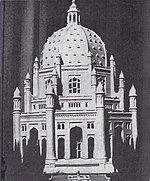

A site has been selected for a Bahá'í Temple in the vicinity of the Bahá'í World Centre on Mount Carmel in Haifa, Israel. It is near the spot where Baháʼu'lláh chanted the Tablet of Carmel, the "Charter of the World Spiritual and Administrative Centers of the Faith on that mountain" according to Shoghi Effendi. A design by Mason Remey was approved by Shoghi Effendi.[59] A photo of that model can be found in Baha'i World vol. XII, p. 548. It now stands in the upper hall of the Mansion of Bahji.[60] In August 1971 the Universal House of Justice erected an obelisk on the site, on the side of which is the Greatest Name.
Eliot, Maine, U.S.
Upon his visit to Green Acre in Eliot, Maine in 1912, Abdu'l-Baha stated that the second Bahá'í House of Worship in the United States would be located there.[61]
Others
As of 1963, sites in the following cities and countries had also been chosen for future temples:[62]
| South America | |
| City | Country |
|---|---|
| Buenos Aires | Argentina |
| La Paz | Bolivia |
| Rio de Janeiro | Brazil |
| Bogotá | Colombia |
| Quito | Ecuador |
| Asunción | Paraguay |
| Lima | Peru |
| Montevideo | Uruguay |
| Caracas | Venezuela |
| Europe | |
| City | Country |
|---|---|
| Vienna | Austria |
| Paris | France |
| Rome | Italy |
| The Hague | Netherlands[63] |
| Oslo | Norway |
| Madrid | Spain |
| Stockholm | Sweden |
| Bern | Switzerland |
| Istanbul | Turkey |
| London | United Kingdom |
| Africa | |
| City | Country |
|---|---|
| Cairo | Egypt |
| Benghazi | Libya |
| Meknes | Morocco |
| Johannesburg | South Africa |
| Tunis | Tunisia |
| Asia-Pacific | |
| City | Country |
|---|---|
| Suva | Fiji |
| Jakarta | Indonesia |
| Auki | Solomon Islands |
| Tokyo | Japan |
| Yangon | Myanmar |
| Auckland | New Zealand |
| Asia | |
| City | Country |
|---|---|
| Baghdad | Iraq |
| Tehran | Iran |
| Haifa | Israel |
| Karachi | Pakistan |
See also
Notes
- Smith, Peter (2000). "Mashriqu'l-Adhkhár". A concise encyclopedia of the Baháʼí Faith. Oxford: Oneworld Publications. p. 235. ISBN 1-85168-184-1.
- Momen, M. (1997). "The Baháʼí Community". A Short Introduction to the Baháʼí Faith. Oxford, UK: One World Publications. ISBN 1-85168-209-0.
- Rafati, V.; Sahba, F. (1989). "Bahai temples". Encyclopædia Iranica.
- "Baháʼí Houses of Worship". Bahai.org. Archived from the original on 29 April 2011. Retrieved 17 April 2011.
- "Plans to build new Houses of Worship announced". Baháʼí World News Service. Baháʼí International Community. 22 April 2012. Retrieved 22 April 2012.
- ʻAbdu'l-Bahá (1982) [1912]. The Promulgation of Universal Peace (Hardcover ed.). Wilmette, Illinois, USA: Baháʼí Publishing Trust. p. 71. ISBN 0-87743-172-8.
- Shoghi Effendi to an individual believer, pg 311 Lights of Divine Guidance (volume 1).
- ʻAbdu'l-Bahá (1978). Selections From the Writings of ʻAbdu'l-Bahá (Hardcover ed.). Wilmette, Illinois, USA: Baháʼí Publishing Trust. p. 65. ISBN 0-85398-081-0.
- Momen, Moojan. "Haziratu'l-Quds". Archived from the original on 10 February 2007. Retrieved 20 March 2007.
- Baháʼí World Centre (2 July 1998). "Unpublished compilation on Haziratu'l-Quds and Mashriqu'l-Adhkar". Retrieved 20 March 2007 – via Baháʼí Library Online.
- Taherzadeh, A. (1984). The Revelation of Baháʼu'lláh, Volume 3: 'Akka, The Early Years 1868-77. Oxford, UK: George Ronald. p. 347. ISBN 0-85398-144-2.
- "Baha'i House of Worship - Ashkabad, Central Asia". The National Spiritual Assembly of the Baha'is of the United States. 2007. Archived from the original on 8 August 2007. Retrieved 3 August 2007.
- John Richardson (December 1997). "Preserving the Bahaʼi House of Worship: Unusual Mandate, Material, and Method" (PDF). Cultural Resource Management. National Park Service. p. 50. Archived from the original (PDF) on 27 May 2010. Retrieved 30 June 2010.
- Visitor's Center brochure, October 2007.
- Whitmore (1984).
- Village of Wilmette, Illinois (14 December 2004). "Affordable Housing Plan" (PDF). p. 9. Archived from the original (pdf) on 6 December 2010. Retrieved 30 June 2010.
- National Spiritual Assembly of the Baha'is of the United States (30 April 2007). "It's official! Baha'i House of Worship voted 1 of 7 Wonders of Illinois". Archived from the original on 6 July 2010. Retrieved 30 June 2010..
- UGPulse Uganda
- National Spiritual Assembly of the Baháʼís of Australia (2006). "Baháʼí House of Worship: Construction". Archived from the original on 25 June 2007. Retrieved 17 June 2007.
- National Spiritual Assembly of the Baháʼís of Australia (2006). "Baháʼí House of Worship: Facilities". Archived from the original on 25 June 2007. Retrieved 17 June 2007.
- "Mashriqu'l-Adhkár". Baháʼí Encyclopedia Project. Retrieved 31 December 2018.
- "Mother Temple of Europe Dedicated; Dedication Program". Baha'i News (402). September 1964. p. 2. Retrieved 25 April 2020.
- "Messages from the Universal House of Justice 1963-86". bahai-library.com. Retrieved 24 April 2016 – via Baháʼí Library Online.
- "Achievements of the Seven Year Plan" (PDF). Baháʼí News. July 1987. p. 3. Archived from the original (PDF) on 7 April 2013. Retrieved 2 September 2017 – via Baháʼí Library Online.
- Baha'i House of Worship Samoa.
- "Achievements of the Seven Year Plan" (PDF). Baháʼí News. July 1987. p. 3. Archived from the original (PDF) on 7 April 2013. Retrieved 2 September 2017 – via Baháʼí Library Online.
- "Baháʼí Houses of Worship, India: The Lotus of Bahapur". Baháʼí Association at The University of Georgia. 9 February 2003. Archived from the original on 7 May 2016. Retrieved 12 April 2016.
- Architecture of the Baháʼí House of Worship.
- "Bahá'í World/Volume 18/The Institution of the Mashriqu'l-Adhkár - Bahaiworks, a library of works about the Bahá'í Faith". bahai.works. Retrieved 24 October 2020.
- Faizi, Gloria (1993). Stories about Baháʼí Funds. New Delhi, India: Baháʼí Publishing Trust. ISBN 81-85091-76-5.
- Chakraborty, Debarati. "Newsline 28 September 2006: Here's Delhi's Lotus Temple for you at Singhi Park!". Retrieved 29 May 2007.
- Scott, Alec (July 13, 2006). "Higher Power: Toronto architect Siamak Hariri ascends to architectural greatness", CBC.ca Arts.
- Watkins, Katie. "In Progress: Baháʼí Temple of South America / Hariri Pontarini Architects". archdaily.com. Arch Daily. Retrieved 2 February 2016.
- "Baháʼí House of Worship for South America". templo.bahai.cl/. Retrieved 13 October 2016.
- Official Temple website: Architecture Archived 2012-07-22 at the Wayback Machine.
- BWNS: Excavation work commences for Chile's "temple of light". 28 November 2010. See also Baháʼí Faith in Chile.
- "International Architecture Awards 2017". The Chicago Athenaeum Museum of Architecture and Design. 18 August 2017. Retrieved 13 January 2020.
- "AIA Innovation Award recipients selected". American Institute of Architects. 30 October 2017. Retrieved 17 January 2020.
- "Baháʼí Temple of South America". Architecture MasterPrize. Retrieved 17 January 2020.
- "Winners of 2018 Ontario Association of Architects Awards Revealed". Ontario Association of Architects. 3 April 2018. Retrieved 17 January 2020.
- "Baháʼí Temple of South America". The Institution of Structural Engineers. Retrieved 13 January 2020.
- "Hariri Pontarini Architects Wins 2019 RAIC International $100,000 (CAD) Prize for Excellence in Architecture". Royal Architectural Institute of Canada. 25 October 2019. Retrieved 14 January 2020.
- "Riḍván 2012 - To the Baháʼís of the World". The Universal House of Justice. 21 April 2012. Retrieved 2 September 2017.
- "Spirit and aspirations of a people: Reflections of Temple's architect". Baháʼí World News Service. 31 August 2017. Retrieved 2 September 2017.
- "Preparations for Temple inauguration accelerate | Baháʼí World News Service (BWNS)". Baháʼí World News Service. 11 August 2017. Retrieved 30 August 2017.
- Baháʼí World News Service (BWNS). House of Worship in Battambang, Cambodia
- "Riḍván 2012 - To the Baháʼís of the World". The Universal House of Justice. 21 April 2012. Retrieved 2 September 2017.
- "On eve of dedication, architect reflects on culture, environment, spiritual principle". Baháʼí World News Service. 20 July 2018.
- "Colombia Temple dedicated in joyful ceremony". Baháʼí World News Service. 23 July 2018.
- "Construction advances on historic first national Baha'i House of Worship". Bahá’í World News Service. 24 November 2019. Retrieved 10 November 2020.
- "In Africa: As one temple rises, anticipation builds for another". Bahá’í World News Service. 12 June 2020. Retrieved 10 November 2020.
- "Milestone for Vanuatu Temple uplifts, galvanizes island". Bahá’í World News Service. 17 November 2019. Retrieved 10 November 2020.
- "Groundbreaking for House of Worship celebrated across DRC". Bahá’í World News Service. 18 October 2020. Retrieved 10 November 2020.
- "Local Temple design unveiled in India". Bahá’í World News Service. 29 April 2020. Retrieved 1 November 2020.
- Official US Baháʼí statistics Archived 2007-11-29 at the Wayback Machine.
- A World Survey of the Bahá'í Faith: 1844-1944, Bahá'í Publishing Committee, Wilmette, IL., 1944, p.16
- https://www.bahai-encyclopedia-project.org/index.php?option=com_content&view=article&id=70:mashriqul-adhkar&catid=36:administrationinstitutions
- The Bahá'í World XIV: 1963-1968, p.495, and https://www.bahai-encyclopedia-project.org/index.php?option=com_content&view=article&id=70:mashriqul-adhkar&catid=36:administrationinstitutions
- MacEoin, Denis; Collins, William. "Architecture". The Babi and Baha'i Religions: An Annotated Bibliography. Greenwood Press's ongoing series of Bibliographies and Indexes in Religious Studies. p. 165. Archived from the original on 15 May 2008. Retrieved 20 June 2008 – via Baháʼí Library Online.
- Baha'i World, vol. XII, 1950-1954, pg 548.
- "This is hallowed ground made so by your vision and sacrifice. Always remember this is hallowed ground which I am pointing out to you. This is where the first Baha'i University will be built; this is where the second Baha'i Temple in the United States will be raised"
- Information Statistical and Comparative, Including the Achievements of the Ten Year International Baháʼí Teaching & Consolidation Plan 1953-1963.
- International Survey of Current Bahá’í Activities: The Netherlands. Bahá'í World, Volume 15: 1968-1973. pp. 286.
References
- Badiee, Julie (1992). An Earthly Paradise, Baháʼí Houses of Worship around the World. George Ronald, Oxford, UK. ISBN 0-85398-316-X..
- Badiee, Julie (2009). "Mashriqu'l-Adhkár". Baháʼí Encyclopedia Project. Evanston, IL: National Spiritual Assembly of the Baháʼís of the United States.
- Smith, Peter (2000). A Concise Encyclopedia of the Baháʼí Faith. Oneworld Publications, Oxford, England. ISBN 1-85168-184-1.
- Whitmore, Bruce W. (1984). The Dawning Place: The Building of a Temple, the Forging of the North American Baháʼí Community. Baháʼí Publishing Trust, Wilmette, Illinois, USA. ISBN 0-87743-192-2.
Further reading
- Boyles, Ann. For the Betterment of the World, to the Glory of God - The Emergence of Bahá'í Houses of Worship.
- Research Department of the Universal House of Justice (2017). The Mashriqu'l-Adhkár. (statement and compilation).
External links
| Wikimedia Commons has media related to Bahá'í House of Worship. |
- Bahai.org: The Mashriqu'l-Adhkár
- Mashriqul-Adhkar.com - An Online Compilation (archived)
- The Bahá'í Houses of Worship around the world as seen from Google Earth
- Official Website of the Bahá'í House of Worship in Australia
- Official Website Bahá'í House of Worship in Chile
- Official Website Bahá'í House of Worship in Germany
- Official Website Bahá'í House of Worship in India
- The official Website Bahá'í House of Worship in Samoa
- Baha'i Community of Uganda celebrates its 50th anniversary
- The Baha'i House of Worship in Uganda
- Official Website of the Bahá'í House of Worship in the United States
- Chronology and related documents on Bahá'í Library Online
- Related articles on Baha'i World News Service